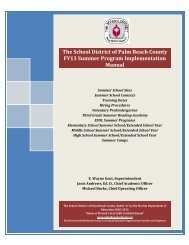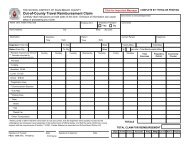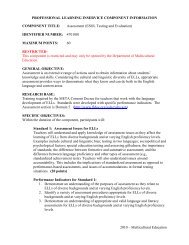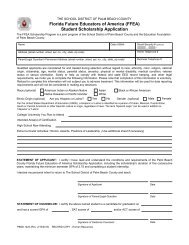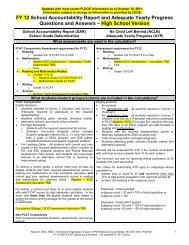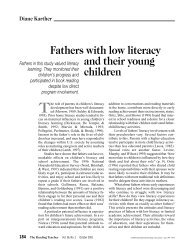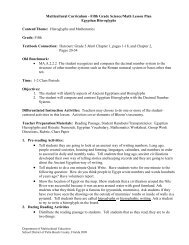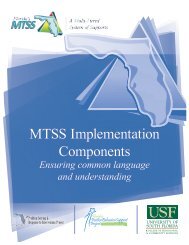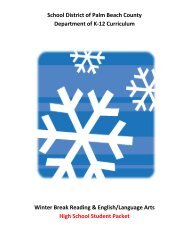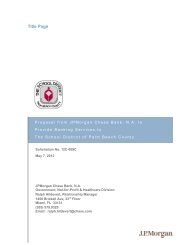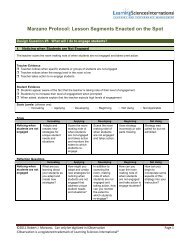Developing an Appropriate Educational Plan (EP) for Students Who ...
Developing an Appropriate Educational Plan (EP) for Students Who ...
Developing an Appropriate Educational Plan (EP) for Students Who ...
You also want an ePaper? Increase the reach of your titles
YUMPU automatically turns print PDFs into web optimized ePapers that Google loves.
<strong>Developing</strong> <strong>an</strong><br />
<strong>Appropriate</strong><br />
<strong>Educational</strong> Pl<strong>an</strong> (<strong>EP</strong>)<br />
<strong>for</strong> <strong>Students</strong> <strong>Who</strong> Are<br />
Gifted<br />
Anne S. Faivus<br />
Specialist, Gifted Education<br />
Palm Beach School District
State Rule 6A-6.030191, 6.030191, F.A.C.,<br />
Development of <strong>Educational</strong> Pl<strong>an</strong>s <strong>for</strong><br />
Exceptional <strong>Students</strong> who are Gifted<br />
• <strong>Educational</strong> Pl<strong>an</strong>s (<strong>EP</strong>s) are developed <strong>for</strong> students<br />
identified solely as gifted.<br />
• Procedures <strong>for</strong> development of the <strong>EP</strong>s shall be set<br />
<strong>for</strong>th in each district's Policies <strong>an</strong>d Procedures <strong>for</strong><br />
the Provision of Specially Designed Instruction <strong>an</strong>d<br />
Related Services to Exceptional <strong>Students</strong> document.<br />
• Procedures shall be consistent with the<br />
requirements in rule.
Meeting the Needs of the Student<br />
• Gifted children have specific characteristics that present<br />
special learning needs which h are best addressed d by<br />
modification of the curriculum.<br />
• Differentiation is a strategy <strong>for</strong> tailoring the curriculum<br />
<strong>an</strong>d instructional strategies which involves adapting<br />
content, ,p process, ,p product, <strong>an</strong>d/or learning environment<br />
to provide appropriately challenging learning experiences<br />
<strong>for</strong> students.<br />
• Varying instructional pace is <strong>an</strong> import<strong>an</strong>t strategy <strong>for</strong><br />
delivering curricula appropriately to the gifted learner,<br />
thus allowing students to learn at their own rate.
Providing Challenge<br />
• Challenging gifted students to achieve at a level of<br />
excellence <strong>an</strong>d expertise requires curriculum <strong>an</strong>d<br />
instruction that will stimulate adv<strong>an</strong>ced learners.<br />
• To ensure continued progress, it is imperative that<br />
the LEVEL, COMPLEXITY, <strong>an</strong>d PACE of curricula be<br />
more matched to a student's readiness <strong>an</strong>d<br />
motivation.<br />
• Gifted students benefit when the modification <strong>an</strong>d<br />
adaptation of curriculum <strong>an</strong>d instruction enables<br />
them to realize their full potential.
How Gifted <strong>Students</strong> Learn<br />
• Gifted students learn at different rates.<br />
• Gifted students vary in their ability to think at adv<strong>an</strong>ced<br />
levels.<br />
• For gifted learners, activities must move at <strong>an</strong><br />
instructional i pace that is com<strong>for</strong>table <strong>an</strong>d reflects their<br />
mental processing speed.<br />
• Additionally, the instructional pace must be flexible so<br />
that the learners are challenged, but also given time to<br />
think about ideas <strong>an</strong>d to process in<strong>for</strong>mation.
What is <strong>an</strong> <strong>Educational</strong> Pl<strong>an</strong> (<strong>EP</strong>)?<br />
• Once it is determined that a student is eligible to<br />
receive service, the <strong>Educational</strong> Pl<strong>an</strong> (<strong>EP</strong>) team meets<br />
to determine what steps to take to ensure <strong>an</strong><br />
appropriate education to meet the needs of the<br />
student. This team develops the <strong>EP</strong>.<br />
• The <strong>EP</strong> is written pl<strong>an</strong> <strong>for</strong> each child who is identified<br />
as eligible <strong>for</strong> gifted education describing the<br />
student’s educational needs <strong>an</strong>d the services that will<br />
be provided to meet those needs.
What is <strong>an</strong> <strong>Educational</strong> Pl<strong>an</strong> (<strong>EP</strong>)?<br />
(Cont'd)<br />
• The <strong>EP</strong> provides detailed in<strong>for</strong>mation about the<br />
appropriate education to meet the needs of that<br />
student . This in<strong>for</strong>mation is useful to school<br />
personnel <strong>an</strong>d to the parents.<br />
• The <strong>EP</strong> provides a clear picture of the student, how the<br />
student is gifted, <strong>an</strong>d the student’s s special needs<br />
related to the giftedness.<br />
• Those special needs include differentiated curricular<br />
experiences to ensure continual student progress <strong>an</strong>d<br />
learning.
<strong>Who</strong> should be at <strong>an</strong> <strong>EP</strong> meeting?<br />
(according to Rule 6A-6.030191)<br />
6.030191)<br />
• The parent/guardi<strong>an</strong>s of student<br />
• At least one teacher of the gifted program<br />
• The regular education teacher (initial <strong>EP</strong> meeting)<br />
• School district representative (LEA / ESE contact)<br />
• School psychologist (initial <strong>EP</strong> meeting)<br />
• Other individuals who may have knowledge of the<br />
student at the discretion of the parent /guardi<strong>an</strong><br />
or school district<br />
• The student, as appropriate
Another Point About <strong>EP</strong> Meetings<br />
• <strong>EP</strong> meetings, g, like I<strong>EP</strong> meetings, g,<br />
are individual<br />
meetings. (Technical Assist<strong>an</strong>ce Paper #12720:<br />
Development of <strong>Educational</strong> Pl<strong>an</strong>s <strong>for</strong> <strong>Students</strong> <strong>Who</strong><br />
Are Gifted)<br />
• The l<strong>an</strong>guage in the <strong>EP</strong> rule states that discussion at<br />
the meeting should focus on the individual student’s<br />
current levels of per<strong>for</strong>m<strong>an</strong>ce <strong>an</strong>d critical in<strong>for</strong>mation<br />
regarding the strengths <strong>an</strong>d interests of the child,<br />
his/her progress, <strong>an</strong>d needs resulting from the child’s<br />
giftedness, based on recent evaluations, class work,<br />
<strong>an</strong>d/or state <strong>an</strong>d diagnostic assessments.
Another Point (Cont'd)<br />
• These subjects are not intended to be covered with other<br />
parents or students td t present.<br />
• It should be noted that the corresponding rules regarding g<br />
the<br />
development of I<strong>EP</strong>s, service pl<strong>an</strong>s or individual family support<br />
pl<strong>an</strong>s also no not address the issue of group as opposed to<br />
individual meetings.<br />
• The intent of the <strong>EP</strong> meeting is to look at how the student is<br />
gifted <strong>an</strong>d what this student needs to address his or her<br />
strengths <strong>an</strong>d needs appropriately. A discussion of such<br />
individual strengths <strong>an</strong>d needs in a group meeting would<br />
represent a violation of the student’s confidentiality <strong>an</strong>d privacy<br />
rights.
Rule<br />
6A-6.030191<br />
6.030191, (4) FAC<br />
F.A.C.<br />
DEFINES THE CONTENT OF THE EDUCATION PLAN (<strong>EP</strong>)<br />
(4) Contents of Education Pl<strong>an</strong>s (<strong>EP</strong>s). <strong>EP</strong>s <strong>for</strong> students<br />
who are gifted must include:<br />
#1<br />
(a) A statement of the student's present levels of<br />
per<strong>for</strong>m<strong>an</strong>ce which may include, but is not limited to,<br />
the student's strengths <strong>an</strong>d interests, the student's<br />
needs beyond the general curriculum, results of the<br />
student's per<strong>for</strong>m<strong>an</strong>ce on state <strong>an</strong>d district<br />
assessments, <strong>an</strong>d evaluation results;<br />
#2<br />
(b) A statement t t of goals, including benchmarks or<br />
short term objectives;
Rule<br />
6A-6.030191, 6.030191, (4) F.A.C.<br />
#3<br />
(c) A statement of the specially designed<br />
instruction to be provided to the student;<br />
#4<br />
(d) A statement of how the student's progress<br />
toward the goals will be measured <strong>an</strong>d reported<br />
to parents; <strong>an</strong>d<br />
#5<br />
(e) The projected date <strong>for</strong> the beginning i g of<br />
services, <strong>an</strong>d the <strong>an</strong>ticipated frequency, location,<br />
<strong>an</strong>d duration of those services
Rule 6A-6.030191, 6.030191, ,( (5) F.A.C<br />
(5) Considerations in <strong>EP</strong> development, review <strong>an</strong>d<br />
revision. The <strong>EP</strong> team shall consider the following:<br />
(a) The STRENGTHS of the student <strong>an</strong>d needs<br />
resulting from the student's giftedness.<br />
(b) The results of recent evaluations, including class<br />
work <strong>an</strong>d state or district assessments.<br />
(c) In the case of a student with limited English<br />
proficiency, the l<strong>an</strong>guage needs of the student as<br />
they relate to the <strong>EP</strong>.
Present Level of Per<strong>for</strong>m<strong>an</strong>ce<br />
#1<br />
(a) A statement of the student's present levels of per<strong>for</strong>m<strong>an</strong>ce which may<br />
include, but is not limited to, the student's strengths <strong>an</strong>d interests,<br />
the student's needs beyond the general curriculum, results of the<br />
student's s per<strong>for</strong>m<strong>an</strong>ce on state <strong>an</strong>d district assessments, <strong>an</strong>d<br />
evaluation results;<br />
Establishes a baseline to identify where the student is currently<br />
per<strong>for</strong>ming.<br />
• Student is interested in problem solving in math <strong>an</strong>d likes to design his own problems<br />
• Norm referenced tests (SRI, RRR, i.e.), benchmark assessment <strong>an</strong>d/or other <strong>for</strong>mal<br />
assessments<br />
• Score on the 2008 FCAT <strong>for</strong> Math (Level 4, i.e.) [CANNOT USE FCAT ONLY]<br />
• Pre-assessment at beginning of grade 4 student evidenced mastery of 90 % of the<br />
grade 4 math objectives<br />
• Is earning <strong>an</strong> A-in math
A well-written written present level might<br />
describe:<br />
• The strengths of the child (examples: avid reader, currently<br />
reading at a beginning sixth grade level based the Woodcock-<br />
Johnson, consistently scores 95-100 on weekly spelling tests)<br />
• What helps the child to be successful (prefers working<br />
independently, enjoys researching topics of interest)<br />
• What might be preventing the child from being successful<br />
(frequently doesn’t complete math homework, does not<br />
participate well in small group projects, does not edit his work<br />
<strong>for</strong> grammatical errors)<br />
• Objective data from evaluations in class (grades, end of<br />
chapter or end of year tests, i.e.)<br />
• Teacher or parent observations about work habits (prefers a<br />
quiet place to work, asks m<strong>an</strong>y questions)
State Rule 6A-6.0311, 6.0311, F.A.C., Eligible Special<br />
Programs <strong>for</strong> Exceptional <strong>Students</strong><br />
“Special programs <strong>for</strong><br />
exceptional students<br />
encompass instruction <strong>an</strong>d<br />
related services which<br />
provide signific<strong>an</strong>t<br />
adaptations in one or more<br />
of the following: curriculum,<br />
methodology, materials,<br />
equipment, or environment<br />
designed d to meet the<br />
individual learning needs of<br />
exceptional students.”
State Rule 6A-6.0331, 6.0331, F.A.C., General Education Intervention<br />
Procedures, Identification, Evaluation, Reevaluation <strong>an</strong>d the<br />
Initial Provision of Exceptional Education<br />
• (3) 3 (c) The school district shall be responsible <strong>for</strong><br />
conducting all initial evaluations necessary to determine<br />
if the student is eligible <strong>for</strong> ESE <strong>an</strong>d to determine the<br />
educational needs of the student.<br />
• (5)(a) 1. The school district must use a variety of<br />
assessment tools <strong>an</strong>d strategies to gather relev<strong>an</strong>t<br />
functional, developmental, <strong>an</strong>d academic in<strong>for</strong>mation<br />
about the student, including in<strong>for</strong>mation provided by the<br />
parent, that may assist in determining whether the<br />
student is eligible <strong>for</strong> ESE <strong>an</strong>d the content of the …<strong>EP</strong>,<br />
including in<strong>for</strong>mation related to enabling …a gifted<br />
student’s needs beyond the general curriculum.
Individual Needs<br />
• Curriculum <strong>for</strong> students who are gifted must be<br />
DIFFERENTIATED <strong>for</strong> their specific learning needs.<br />
• Thus, <strong>an</strong> <strong>EP</strong> should be <strong>an</strong> individualized pl<strong>an</strong> <strong>for</strong> how<br />
we intend to assure that this student -- who has met<br />
eligibility criteria -- has his or her special learning<br />
needs appropriately addressed to ensure the student<br />
continues to make academic progress.
Next Step: Goals <strong>an</strong>d Objectives<br />
After looking at where the student is currently per<strong>for</strong>ming,<br />
we then consider:<br />
#2<br />
(b) A statement of goals, including objectives;<br />
As noted earlier ---”To ensure continued progress, it is<br />
imperative that the level, complexity, <strong>an</strong>d pace of<br />
curricula be more matched to a student's readiness <strong>an</strong>d<br />
motivation.”<br />
We consider –”What is this student capable of being able to<br />
do to continue academic progress?”
A well-written written goal will:<br />
• Be positive<br />
• Will clearly describe a skill that c<strong>an</strong> be MEASURED<br />
• Answers the questions:<br />
– WHO<br />
• The student …<br />
– Will do WHAT will<br />
• …Will achieve at least a reading score of 991…<br />
– HOW<br />
• …measured on the SRI profile…<br />
– WHERE<br />
• …with monthly classroom assessments to increase levels…<br />
– WHEN<br />
• …by the end of grade 5
Goals<br />
• When developing goals <strong>an</strong>d objectives, the <strong>EP</strong><br />
team should consider the student’s present level<br />
of per<strong>for</strong>m<strong>an</strong>ce.<br />
• The goals should be individualized.<br />
• The goals CANNOT be uni<strong>for</strong>m goals covering <strong>an</strong><br />
entire class or group.
The <strong>EP</strong> team should ask:<br />
How do you<br />
define<br />
student<br />
achievement?
Domains<br />
• Cognitive processes<br />
• Communications<br />
• Problem solving<br />
• Scientific method<br />
• Study skills<br />
• Research skills<br />
• Independent learning<br />
• Social processes<br />
• Leadership skills<br />
• Technology
Remember<br />
We know that what<br />
gets measured, gets<br />
done.<br />
Each student should<br />
be showing at least<br />
one year’s academic<br />
growth each year.
Possible Goals with Objectives<br />
GOAL: Student will complete grade 5 math curriculum<br />
with 85 % mastery by the end of grade 4.<br />
•By the end of the first nine weeks the student will evidence<br />
mastery of 85% of the grade four math objectives.<br />
•By the end of first semester the student will have completed the<br />
first half of the grade 5 math curriculum with 80% mastery.<br />
•The student will complete at least one activity per week from<br />
Challenge Math with 100% accuracy.
Three Characteristics of<br />
Measureable Goals <strong>an</strong>d Objectives<br />
Per<strong>for</strong>m<strong>an</strong>ce<br />
*What the student is expected to do<br />
Condition<br />
*When <strong>an</strong>d how the student will per<strong>for</strong>m<br />
Criterion<br />
*What is the acceptable level of per<strong>for</strong>m<strong>an</strong>ce
Per<strong>for</strong>m<strong>an</strong>ce: A Doing Word, not <strong>an</strong><br />
Int<strong>an</strong>gible Word.<br />
Doing Words<br />
• Writing<br />
• Producing<br />
• Identifying<br />
• Applying<br />
• Ui<br />
Using<br />
Int<strong>an</strong>gible Words<br />
• Knowing<br />
• Underst<strong>an</strong>ding<br />
• Being<br />
• Comprehending
Condition<br />
When <strong>an</strong>d how the student will per<strong>for</strong>m<br />
1. In a given nine weeks……<br />
2. Using the math textbook……<br />
3. Using supplementary materials…..<br />
4. Using the internet…..
Criterion<br />
How well the student is expected to<br />
per<strong>for</strong>m<br />
1. With 80-89% 89% mastery<br />
2. With 100% mastery
Exp<strong>an</strong>ding the Expectation with<br />
Objectives<br />
GOAL: Student will demonstrate inquiry skills by identifying<br />
a topic, problem or issue of interest <strong>an</strong>d <strong>for</strong>mulating a<br />
minimum of 10 questions <strong>for</strong> research using appropriate<br />
p<br />
tables <strong>an</strong>d graphs by the end of the first trimester of 4 th<br />
grade.<br />
• By the end of the first grading period the student will<br />
have completed a teacher approved product <strong>for</strong> that<br />
topic <strong>an</strong>d applied math skills.
Another example<br />
Establish a baseline:<br />
– Student (grade 4) is <strong>an</strong> avid reader <strong>an</strong>d loves to write<br />
– FCAT reading score last year was a 4.5<br />
– SRI score of 991<br />
– Student has a consistent record of A’s in reading <strong>an</strong>d l<strong>an</strong>guage arts<br />
– Considerations <strong>for</strong> a one year Goal might be:<br />
• Student will use <strong>an</strong>alysis to develop <strong>an</strong> appreciation of <strong>an</strong>d be<br />
able to compare <strong>an</strong>d contrast literary characterizations<br />
• Student will receive instruction in 5 th grade level L<strong>an</strong>guage Arts<br />
course<br />
• Student will use writing as a tool <strong>for</strong> learning by maintaining<br />
learning logs, laboratory reports, note taking, journals, or<br />
writing portfolios
Adding Objectives<br />
GOAL: Student will use <strong>an</strong>alysis to develop <strong>an</strong> appreciation of<br />
literary characterizations<br />
ti<br />
– Student will show evidence of being able to compare <strong>an</strong>d<br />
contrast a minimum of three characters in two literary<br />
classics in a teacher-approved approved product of choice by June<br />
2010<br />
Student will use writing as a tool <strong>for</strong> learning by maintaining<br />
learning logs, laboratory reports, note taking, journals, or<br />
writing portfolios<br />
– Student will maintain a learning log to be assessed by<br />
checklist weekly <strong>for</strong> each grading period<br />
– Student will demonstrate appropriate skills in effective note<br />
taking as evidenced by a rubric by end of grade 4
EXAMPLES<br />
• Student will increase his oral reading fluency by 30%<br />
as evidenced by the completion of ten grade<br />
appropriate reading assessments in class<br />
• Student will improve his vocabulary skills by achieving<br />
a minimum test score of 90% on monthly classroom<br />
assessments.<br />
• Student will successfully compare literature pieces 4<br />
out of 5 times as evidenced by the use of graphic<br />
org<strong>an</strong>izers <strong>an</strong>d/or essays in class.
Examples (Cont'd)<br />
• Student will develop strategies to solve complex,<br />
grade appropriate mathematical problems with 89%<br />
mastery.<br />
• Student will become a higher order thinker 9 out of 10<br />
times as evidenced by classroom work samples that<br />
document the use of synthesis <strong>an</strong>d evaluation skills.<br />
• Student will increase his mathematical computation<br />
abilities by 20% as measured by teacher made tests<br />
completed in the classroom.
Differentiating Thinking Skills<br />
Some service may specifically target thinking skills. If<br />
so, there are key points to keep in mind:<br />
– What evidence do you have that the student needs to<br />
develop creative or critical thinking skills? Establish a<br />
baseline.<br />
– While we know thinking skills c<strong>an</strong> be taught, it is critical that<br />
the thinking be used in connection with other areas of<br />
knowledge. Florida’s Frameworks <strong>for</strong> K-12 Gifted Learners<br />
provides guid<strong>an</strong>ce.<br />
– What materials will be used to instruct students toward<br />
making measurable gains in these areas?
Differentiation<br />
Writing a Goal Defined by Florida’s Frameworks <strong>for</strong><br />
K-12 Gifted Learners<br />
Goal: The student will be able to conduct thoughtful<br />
research/exploration in multiple fields<br />
Objectives:<br />
Student will use a variety of research tools <strong>an</strong>d<br />
methodologies – Student is currently per<strong>for</strong>ming at the Know<br />
level l in terms of cooperative research <strong>an</strong>d will progress to<br />
the Per<strong>for</strong>m level by June 2011<br />
Student will use <strong>an</strong>d m<strong>an</strong>ipulate in<strong>for</strong>mation sources - Student<br />
is currently at the Underst<strong>an</strong>d level in recognizing<br />
in<strong>for</strong>mation in multiple contexts – particularly in math –<strong>an</strong>d<br />
will move to the Per<strong>for</strong>m level by June 2011
#3<br />
(c) A statement of the specially designed instruction to be<br />
provided to the student;<br />
What differentiated instruction will be provided to<br />
ensure the student is able to have the necessary<br />
skills to complete the goals <strong>an</strong>d objectives?<br />
– Teacher will need to develop rubrics with the student to determine<br />
what skills are needed<br />
– Will curriculum compacting move the appropriate instruction<br />
<strong>for</strong>ward? If so, how will that be done?<br />
– Will the student <strong>an</strong>d teacher develop a learning contract to better<br />
be able to track the progress of the student?<br />
– Will a pre-test appropriately identify the current level of skills <strong>an</strong>d<br />
necessary instruction?<br />
– How will the student learn the new skills?
Instructional Strategies/Products<br />
to Consider<br />
• Curriculum compacting<br />
• Lecture<br />
• Discussion<br />
• Guided independent study<br />
• Learning or activity center<br />
• Simulation<br />
• Role play or dramatization<br />
• Learning games<br />
• Internship<br />
• Investigative report<br />
• Other strategies /products that assess learning
#4<br />
d. A statement of how the student's progress toward<br />
the goals will be measured <strong>an</strong>d reported to parents;<br />
<strong>an</strong>d<br />
• Critical step: identify the desired results<br />
• Decide what assessment will best document <strong>an</strong>d evidence<br />
that the student has accomplished the results desired<br />
• TEACHER OBSERVATION c<strong>an</strong> be included, but it is NOT a<br />
reliable measure of accomplishment of skills. Pre- <strong>an</strong>d post-<br />
test assessments may do this. A completed science project<br />
may evidence accomplishment but the project is not the<br />
evaluation – a rubric that is used to assess the project would<br />
be the evaluation.<br />
• KEY: The product is not <strong>an</strong> evaluation.
Reporting Progress to Parents<br />
• How will the parent know that the student is making<br />
progress toward accomplishment of the <strong>EP</strong> goals?<br />
• Waiting until the end of the year to let a parent know does<br />
not allow <strong>for</strong> addressing the situation in a me<strong>an</strong>ingful way.<br />
• If the school district determines all parents should be<br />
notified of student progress every quarter, would that be<br />
<strong>an</strong> appropriate time to notify parents of accomplishment<br />
toward meeting the gifted goals?<br />
• Parents –<strong>an</strong>d students t – deserve to know that t something<br />
me<strong>an</strong>ingful is taking place in the gifted classroom
Assessment<br />
• Assessment should be a measuring stick to determine<br />
how well the student has mastered skills or learning goals.<br />
• The scoring guide should identify what top per<strong>for</strong>m<strong>an</strong>ce,<br />
acceptable per<strong>for</strong>m<strong>an</strong>ce, <strong>an</strong>d subst<strong>an</strong>dard d per<strong>for</strong>m<strong>an</strong>ce<br />
would look like.<br />
• Assures that students are aware of their own learning.<br />
• Pre-assessment is a powerful tool.<br />
• A well developed rubric charts student growth of<br />
underst<strong>an</strong>ding.
Criteria<br />
Criteria might include:<br />
– Student worked intently on task<br />
– Student was able to effectively portray the in<strong>for</strong>mation<br />
required<br />
– Summary was well-written written <strong>an</strong>d grammatically correct<br />
3= excellent 2= satisfactory<br />
1 = unsatisfactory 0= did not complete task
Evidence of mastery<br />
• What documentation will show that the student was<br />
able to accomplish the task?<br />
• What criteria will be used to determine that the<br />
student minimally addressed the goal vs. evidencing a<br />
signific<strong>an</strong>t accomplishment?<br />
• Raise The Bar! If you allow minimal per<strong>for</strong>m<strong>an</strong>ce<br />
st<strong>an</strong>dards, that is what you will get.<br />
• Documenting evidence of skill mastery supports more<br />
appropriate curriculum needs.
#5<br />
(e) Projected date <strong>for</strong> beginning of services, the <strong>an</strong>ticipated<br />
frequency, location, <strong>an</strong>d duration of services;<br />
• When will service begin?<br />
• How often will the child<br />
receive service? (number of<br />
days per week or times per<br />
day or week)<br />
• How long will each session<br />
last?<br />
• Where will service be<br />
provided?
“Although the gifted<br />
share common<br />
characteristics, they also<br />
differ from each other in<br />
needs, abilities, <strong>an</strong>d<br />
interests. There<strong>for</strong>e, <strong>an</strong>y<br />
curriculum must be<br />
modified to accommodate<br />
the individual gifted<br />
learner…”<br />
S<strong>an</strong>dra Kapl<strong>an</strong>
Closing Thoughts<br />
Gifted education is not a privilege – it<br />
is a specific need.<br />
The need <strong>for</strong> service is documented<br />
when the student is determined<br />
eligible <strong>for</strong> gifted service.
ASK:<br />
•How is this student<br />
gifted?<br />
•What special<br />
education does this<br />
student need beyond<br />
what is available?
References/Resources<br />
• L<strong>an</strong>drum, M.S., Callah<strong>an</strong>, C.M., & Shaklee, B.D. (eds.). (2001). Aiming<br />
<strong>for</strong> Excellence: Gifted program st<strong>an</strong>dards. Waco, TX: Prufrock Press.<br />
• Tomlinson, C.A. (1999). The differentiated classroom: responding to<br />
the needs of all learners. Alex<strong>an</strong>dria, VA: ASCD.<br />
• Tomlinson, C.A., Kapl<strong>an</strong>, S., Renzulli, J., Purcell, J., Leppien, J., Burns, D.<br />
(2002). The parallel curriculum: A design to develop high potential <strong>an</strong>d<br />
challenge high-ability learners. Thous<strong>an</strong>d Oaks, CA: Corwin Press.<br />
• V<strong>an</strong>Tassel-Baska, J.(ed.) (2004). Curriculum <strong>for</strong> gifted <strong>an</strong>d talented<br />
students. . Thous<strong>an</strong>d Oaks, CA: NAGC <strong>an</strong>d Corwin Press.



